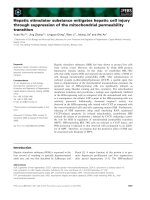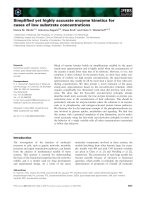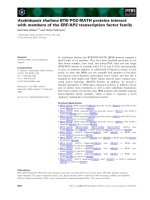Báo cáo khoa học: " SCLC extensive disease – treatment guidance by extent or/and biology of response?" pptx
Bạn đang xem bản rút gọn của tài liệu. Xem và tải ngay bản đầy đủ của tài liệu tại đây (164.59 KB, 3 trang )
BioMed Central
Page 1 of 3
(page number not for citation purposes)
Radiation Oncology
Open Access
Commentary
SCLC extensive disease – treatment guidance by extent or/and
biology of response?
Franziska Eckert and Arndt-Christian Müller*
Address: Department of Radiooncology, Eberhard-Karls-University Tübingen, Germany
Email: Franziska Eckert - ; Arndt-Christian Müller* -
* Corresponding author
Abstract
In extensive disease of small cell lung cancer a doubling of the one-year-survival rate was reported
in August 2007 by prophylactic cranial irradiation applied to patients who experienced any
response to initial chemotherapy. We discuss the treatment concept of extensive disease in the
face of the latest results and older studies with additional thoracic irradiation in this subgroup. A
randomized trial with prophylactic cranial irradiation published in 1999 demonstrated an
improvement of 5-year-overall-survival for complete responders (at least at distant levels) receiving
additional thoracic radiochemotherapy compared to chemotherapy alone (9.1% vs. 3.7%). But,
these results were almost neglected and thoracic radiotherapy was not further investigated for
good responders of extensive disease. However, in the light of current advances by prophylactic
cranial irradiation these findings are noteworthy on all accounts. Considering both, a possible
interpretation of these data could be a survival benefit of local control by simultaneous thoracic
radiochemotherapy in the case of improved distant control due to chemotherapy and prophylactic
cranial irradiation. Furthermore the question arises whether the tumor biology indicated by the
response to chemotherapy should be integrated in the present classification.
Background
Extensive disease of small cell lung cancer (ED-SCLC) is
still a therapeutical challenge. The median survival time
without treatment reaches two to four months [1]. Stand-
ard therapy with four to six cycles of chemotherapy pro-
longs the median survival time to six to nine months.
Even with the achievement of a complete response (CR),
only a few months more are added to the short life expect-
ancy.
The investigations of the last years mainly concentrated
on more effective and less toxic drug regimens or on tar-
geted therapies, but until now these attempts did not bear
essential success. Astonishingly, a doubling of the one-
year-survival rate was reported in August 2007 for a "con-
ventional" technique: Prophylactic cranial irradiation
(PCI) applied to patients who experienced any response
to the initial chemotherapy [2].
PCI and ED-SCLC
For the first time an improved survival was shown for PCI
by the mentioned EORTC-study in this favorable sub-
group (at least partial response to chemotherapy). The
bottom line was an increase of overall survival (27 vs.
13% one-year survival) based on improved local control
with a highly significant reduction of symptomatic cere-
bral metastasis for patients treated with PCI (41 vs. 17%).
With the shortest of the applied radiation regimens this
Published: 2 October 2008
Radiation Oncology 2008, 3:33 doi:10.1186/1748-717X-3-33
Received: 1 April 2008
Accepted: 2 October 2008
This article is available from: />© 2008 Eckert and Müller; licensee BioMed Central Ltd.
This is an Open Access article distributed under the terms of the Creative Commons Attribution License ( />),
which permits unrestricted use, distribution, and reproduction in any medium, provided the original work is properly cited.
Radiation Oncology 2008, 3:33 />Page 2 of 3
(page number not for citation purposes)
meant a gain in overall-survival of six weeks (5.4 vs. 6.7
months median survival) with a therapy of one week. The
assessed quality of life was significantly better in the radi-
ation group due to acceptable toxicities and reduced mor-
bidity caused by cerebral metastasis. An additional
advantage of PCI and related lower morbidity was the
increased applicability of second-line chemotherapy. The
study was designed with focus on easy feasibility and cost-
effectiveness. So, patients with symptomatic brain metas-
tases were excluded and cross sectional imaging was not
routinely demanded but performed in case of defined key
symptoms. However, treatment of occult brain metastasis
by PCI cannot be finally ruled out. Despite of this poten-
tial limitation, an older meta-analysis evaluating com-
plete responders of SCLC illustrates the main principle
that PCI improves survival (benefit of 5.4% at 3 years) [3].
Approximately 20% of complete responders included in
this meta-analysis were staged as extensive disease. The
subgroup-analysis revealed no significant difference
between limited and extensive disease (relative risk of
death for limited/extensive SCLC: 0.85 vs. 0.77 p= 0.88).
Local recurrence plays an increasing role in ED-SCLC.
After thoracic radiation treatment, in-field relapse
occurred in 24% of the cases as the first site of relapse [4].
Without local treatment 89–93% patients suffered from
local progress in the first year after primary therapy [2].
Additional local radiotherapy for extensive disease?
Already in 1999 a study performed by a Serbian group [5]
evaluated different local treatment approaches depending
on response to initial chemotherapy. Those who had
complete response at least at distant levels were rand-
omized to receive either two courses of cisplatin/etopo-
side (each 80 mg/m
2
) or TRT with daily carboplatin/
etoposide (each 50 mg/m
2
). Subsequently, PCI and two
more courses chemotherapy were performed. Interest-
ingly thoracic radiochemotherapy improved 5-year over-
all-survival compared to chemotherapy (9.1% vs. 3.7%).
Four older studies [6-9] investigating the value of TRT
without standard PCI for extensive disease were unable to
detect any benefit from treatment. However, besides
absence of PCI, chemotherapy was applied sequentially
and not concurrent with TRT. Furthermore, the limited
case number of all four trials together (129 vs. 109 in the
study of Jeremic et al.) suggests a lower statistical power of
the negative studies. Staging deficits of the earlier investi-
gations in the late eighties might also be assumed. A pos-
sible interpretation of these data on TRT could be a
survival benefit of local control by simultaneous radio-
chemotherapy in the case of improved distant control due
to chemotherapy and PCI. TRT has never been imple-
mented into clinical treatment concepts for ED-SCLC.
However, these findings are noteworthy on all accounts
potentially improving the outcome of good responders
with extensive disease.
Conclusion
Taken together the results of Slotman et al. and Jeremic et
al. lead to the question whether the treatment for exten-
sive disease SCLC should be reconsidered. There could be
three different treatment strategies according to initial
response to chemotherapy: Chemotherapy plus TRT
(simultaneously with the 4
th
cycle) and PCI for good
responders achieving complete remission at least at dis-
tant levels; chemotherapy and PCI for patients having less
than complete response; second line chemotherapy or
best supportive care for stable or progressive disease (Fig-
ure 1). If this therapy was established, the difference in
treatment of limited and extensive disease in complete
responders would diminish. The best estimated 5-year-
overall-survival for the described schedule could exceed
20% for limited and reach almost 10% for extensive dis-
ease [4,5,10]. Based on the available data the question
arises, whether the present classification should be sup-
plemented by biology of response. Surely, randomized tri-
als are essential to evaluate this proposed procedure.
Furthermore, the significance of potential confounders
like treatment of asymptomatic brain metastasis by PCI,
prognostic relevance of metastatic pattern within the het-
erogeneous group of ED-SCLC and subsequent second
line treatment could be analyzed.
Suggested treatment strategy for ED-SCLCFigure 1
Suggested treatment strategy for ED-SCLC. Based on
recent and older, hardly considered data [2,5] there could be
three different treatment strategies according to initial
response to chemotherapy: Chemotherapy plus TRT (simul-
taneously with the 4
th
cycle) and PCI for good responders
achieving complete remission at least at distant levels; chem-
otherapy and PCI for patients having any response; second
line chemotherapy or best supportive care for stable or pro-
gressive disease.
3 x
Chemotherapy
CR
at least distant control
PR SD/PD
Chemotherapy
switch if indicated
Chemotherapy
(to a total of 4-6 cycles)
Chemotherapy
plus TRT
PCI PCI
ED-SCLC
Publish with BioMed Central and every
scientist can read your work free of charge
"BioMed Central will be the most significant development for
disseminating the results of biomedical research in our lifetime."
Sir Paul Nurse, Cancer Research UK
Your research papers will be:
available free of charge to the entire biomedical community
peer reviewed and published immediately upon acceptance
cited in PubMed and archived on PubMed Central
yours — you keep the copyright
Submit your manuscript here:
/>BioMedcentral
Radiation Oncology 2008, 3:33 />Page 3 of 3
(page number not for citation purposes)
Competing interests
The authors declare that they have no competing interests.
Authors' contributions
FE drafted the manuscript, drafted the figure. ACM con-
ceived the manuscript. All authors read and approved the
final manuscript.
References
1. Samson DJ, Seidenfeld J, Simon GR, Turrisi AT 3rd, Bonnell C, Ziegler
KM, Aronson N: Evidence for management of small cell lung
cancer: ACCP evidence-based clinical practice guidelines
(2nd edition). Chest 2007, 132:314S-323S.
2. Slotman B, Faivre-Finn C, Kramer G, Rankin E, Snee M, Hatton M,
Postmus P, Collette L, Musat E, Senan S: Prophylactic cranial irra-
diation in extensive small-cell lung cancer. N Engl J Med 2007,
357:664-672.
3. Auperin A, Arriagada R, Pignon JP, Le Pechoux C, Gregor A, Stephens
RJ, Kristjansen PE, Johnson BE, Ueoka H, Wagner H, Aisner J: Pro-
phylactic cranial irradiation for patients with small-cell lung
cancer in complete remission. Prophylactic Cranial Irradia-
tion Overview Collaborative Group. N Engl J Med 1999,
341:476-484.
4. Saito H, Takada Y, Ichinose Y, Eguchi K, Kudoh S, Matsui K, Nakagawa
K, Takada M, Negoro S, Tamura K, et al.: Phase II study of etopo-
side and cisplatin with concurrent twice-daily thoracic radio-
therapy followed by irinotecan and cisplatin in patients with
limited-disease small-cell lung cancer: West Japan Thoracic
Oncology Group 9902. J Clin Oncol 2006, 24:5247-5252.
5. Jeremic B, Shibamoto Y, Nikolic N, Milicic B, Milisavljevic S, Dagovic
A, Aleksandrovic J, Radosavljevic-Asic G: Role of radiation ther-
apy in the combined-modality treatment of patients with
extensive disease small-cell lung cancer: A randomized
study. J Clin Oncol 1999, 17:2092-2099.
6. Brincker H, Hindberg J, Hansen PV: Cyclic alternating polychem-
otherapy with or without upper and lower half-body irradia-
tion in small cell anaplastic lung cancer. A randomized study.
Eur J Cancer Clin Oncol 1987, 23:205-211.
7. Lebeau B, Chastang C, Brechot JM, Capron F: A randomized trial
of delayed thoracic radiotherapy in complete responder
patients with small-cell lung cancer. Petites Cellules Group.
Chest 1993, 104:726-733.
8. Nou E, Brodin O, Bergh J: A randomized study of radiation
treatment in small cell bronchial carcinoma treated with
two types of four-drug chemotherapy regimens. Cancer 1988,
62:1079-1090.
9. Rosenthal MA, Tattersall MHN, Fox RM, Woods RL, Brodie GN:
Adjuvant thoracic radiotherapy in small cell lung cancer:
ten-year follow-up of a randomized study. Lung Cancer 1991,
7:235-241.
10. Turrisi AT 3rd, Kim K, Blum R, Sause WT, Livingston RB, Komaki R,
Wagner H, Aisner S, Johnson DH: Twice-daily compared with
once-daily thoracic radiotherapy in limited small-cell lung
cancer treated concurrently with cisplatin and etoposide. N
Engl J Med 1999, 340:265-271.









